Excerpts from Jim Conrad's
Naturalist Newsletter
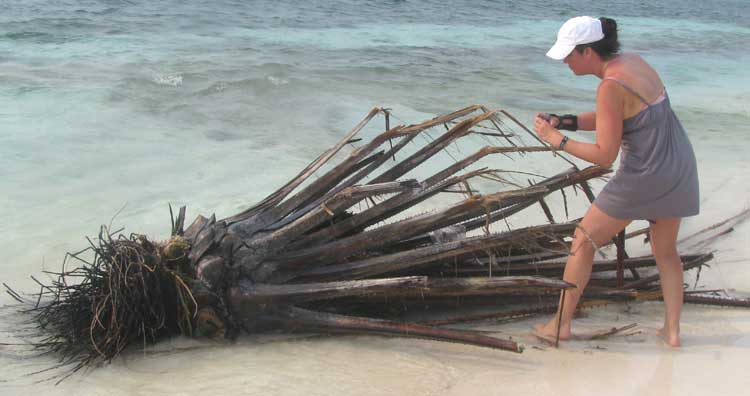
from the May 15, 2011 Newsletter issued from written at Mayan Beach Garden Inn 20 kms north of Mahahual; Caribbean coastal beach and mangroves, ~N18.89°, ~W87.64°, Quintana Roo state, MÉXICO
WENDY'S MONSTER
Each morning I offer a two-hour nature hike up the road beside the mangrove swamp, then back along the beach. The other day Wendy from Maine accompanied me. Wendy is a very experienced beach walker, having recently hiked 450 miles along the coast from Cancun to Belize, passing through here on the way. Her blog can be accessed here. When you get to that page, scroll down to see her pictures and text.
Despite all that time on the beach, neither Wendy nor I had ever seen anything quite like the washed-up monstrosity encountered on our walk, which you can see above. Wendy presents programs to school kids, and she habitually frames descriptions of her experiences on the beach in terms that kids like. Thus we had a sea monster here. And it was my job to figure out what kind of monster it was.
Up close the slender "legs" bore spines, as shown below:
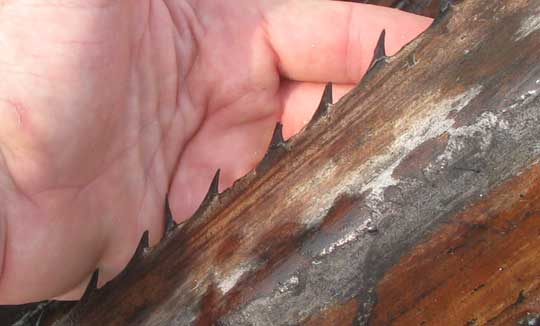
Nestled at the base where the "legs" came together were basketball-size bunches of fruits, shown below:
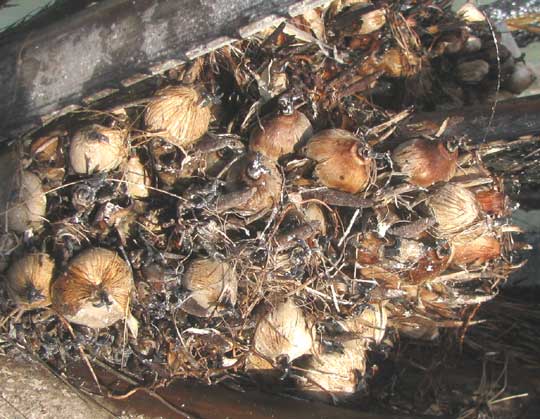
The spines looked to me like those found on petioles of some palm species, and the fruits looked like palm fruits. However, I'd never seen a palm like this.
It took some Googling to figure out that this was an Oil Palm, genus ELAEIS. You may have heard complaints by environmentalists about vast tracts of tropical forest being replaced with monoculture Oil Palm plantations. There are two species of Oil Palm, an African one, Elaeis guineensis, and a tropical American one, Elaeis oleifera, the latter found in Central and South America, but not here.
Traditionally the African species has been planted, but my impression is that nowadays a hybrid between the two species is preferred, so a good guess would be that we have a hybrid. On the Internet I find Oil Palm plantations in Honduras and Surinam. Lots of our beach trash originates in Honduras so maybe our monster came from there.
Oil Palm oil is used mainly for cooking food and making soap. As a food oil, the essential thing to know is that palm oil contains more saturated fats than oils made from canola, corn, linseed, soybeans, safflower, and sunflowers, but palm oil can withstand extreme deep-frying heat and resists oxidation better than other oils. Therefore, palm oil is worse for the body, but better for preparing junk food with a long shelf life.
from the July 17, 2016 Newsletter issued from Hacienda Chichen Resort beside Chichén Itzá Ruins, central Yucatán MÉXICO
OIL PALM PLANTATIONS IN CHIAPAS
During my April trip to the Chiapas frontier with Guatemala I noted many changes since my last visit several years ago -- mainly much deforestation. Another change was the appearance of oil palm plantations, one of which I snapped a picture of from the microbus window on the road between Palenque and Bonampak, shown below:
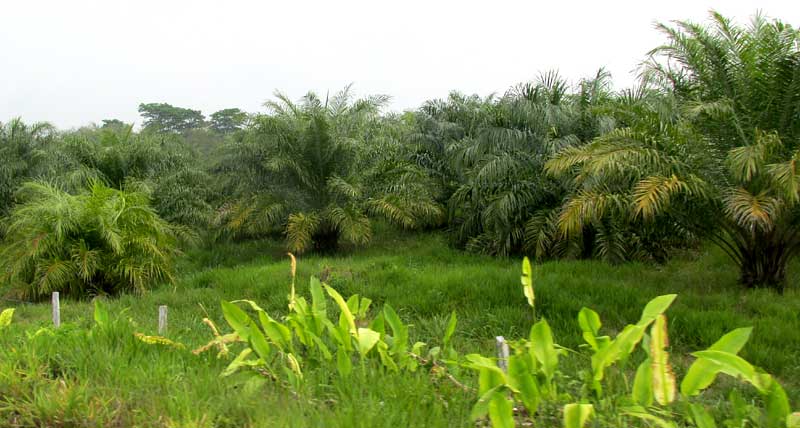
In that picture, the yellowish-green plants with broad leaves are heliconias, members of the Banana Family with very pretty flowers. It's too arid for heliconias to grow wild in the northern Yucatan, but in Chiapas they grow in marshes and ditch bottoms.
At least three species are known as oil palms, but the more commonly grown one, sometimes known as African Oil Palm, is ELAEIS GUINEENSIS, native to west and southwest Africa. Also there's Elaeis oleifera and Attalea maripa. The ones in our picture look like African Oil Palms, but identifying from the window of a speeding van is risky.
Oil palm plantations are controversial. On the one hand, they can enable small farmers to make some money, but on the other, in many areas where laws are not enforced or don't exist, already-threatened rainforest is being cleared away, causing enormous environmental destruction and loss of important species, to oil palm plantations. The problem is worst in Southeast Asia.
Oil Palm oil is used mainly for cooking food and making soap. As a food oil, the essential thing to know is that palm oil contains more saturated fats than oils made from canola, corn, linseed, soybeans, safflower, and sunflowers, but palm oil can withstand extreme deep-frying heat and resists oxidation (going rancid) better than other oils. Therefore, palm oil is worse for the body, but better for preparing junk food with a long shelf life. In recent years the price of palm oil has risen higher than otherwise it might be because it's often used in biofuel production, especially biodiesel.
All the usual problems associated with human overpopulation on a planet with limited and disappearing resources are associated with palm oil production. Wikipedia's pages on the matter state do a good job stating the pros and cons.
You can learn much more about the palms themselves at https://en.wikipedia.org/wiki/Elaeis_guineensis.
Learn about palm oil, it's production, and the environmental effects of its production, at https://en.wikipedia.org/wiki/Palm_oil.
from the December 25, 2016 Newsletter issued from Rancho Regensis north of Valladolid, Yucatán, MÉXICO;
elevation ~40m (~130 ft), N~20.876°, W~88.170°
OIL PALM DETAILS
Until now we've never been able to take a close look at a living specimen. Here at the rancho an Oil Palm has planted, mostly for novelty's sake, and below you can see it, with Chichan 'Cho' the edible Mexican Hairless dog posing beside it:
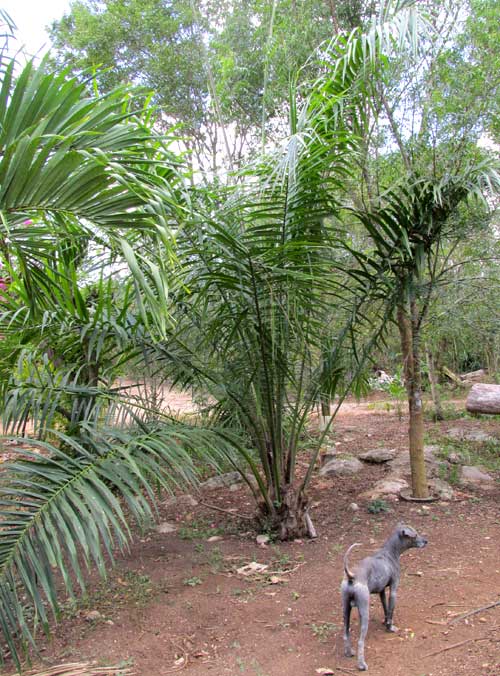
It's a young tree without flowers or fruits, but its fronds show interesting features worth knowing when trying to identify it. For example, below, look at the unusual way pinnae bases attach to the petiole:
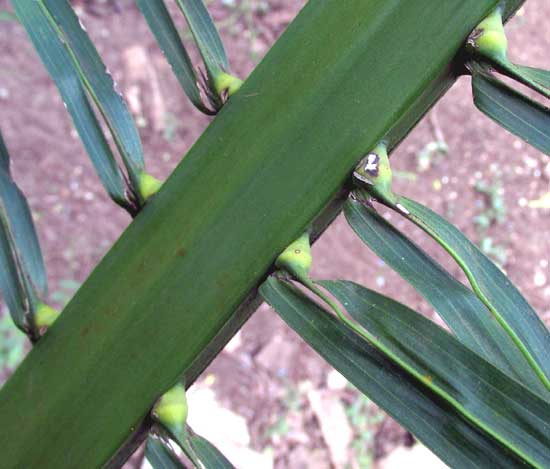
Notice that the bases are split, with one side swelling. It looks like these swellings, once the pinnae dry up and fall away on older fronds, form the spines we've seen at the bases of old fronds, shown at the top of this page.
Below, a shot taken lower down the frond shows how the pinnae diminish nearer the trunk as the swellings become ever more spiny:
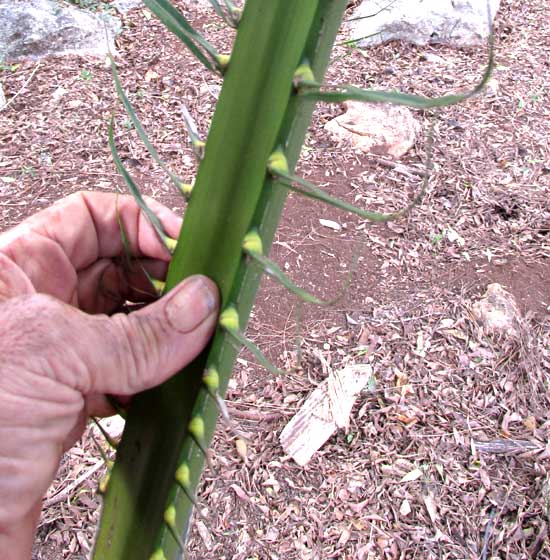
from the February 26, 2017 Newsletter issued from Rancho Regensis north of Valladolid, Yucatán, MÉXICO;
elevation ~40m (~130 ft), N~20.876°, W~88.170°
OIL PALM'S MALE FLOWERS
This week at the rancho another planted Oil Palm tree turned up, this one bearing a large cluster of spiky flowering heads looking like a bunch of up-curved, eight-inch long (20cm), shaggy frankfurters, and bearing only tiny, densely packed male flowers. Below, you can see what this looked like:
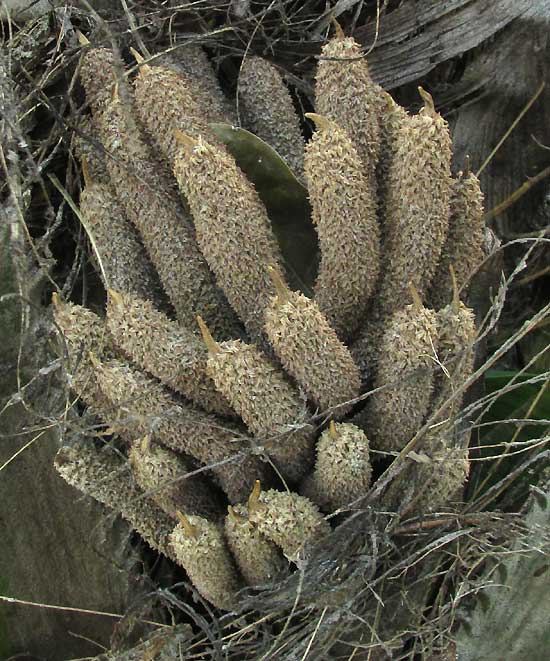
The flowering heads' shagginess consists of old anthers that have already split open, released their pollen, and matted together after a few showers. Below, you can see some spent anthers at the top of a flowering head
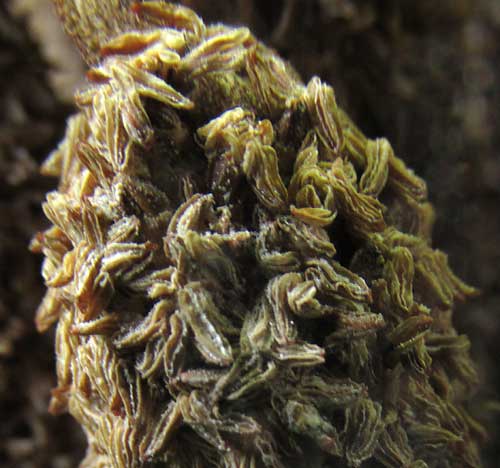
Oil Palms are "monoecious," meaning that all-male and all-female flowers occur on the same plant. Some time ago on another of the rancho's Oil Palms an item looking like a crudely made, dark green whiskbroom appeared among the tree's petiole bases but didn't develop, maybe because no male inflorescences were nearby, or maybe from lack of water.
from the September 3, 2017 Newsletter issued from Rancho Regensis north of Valladolid, Yucatán, MÉXICO;
elevation ~40m (~130 ft), N~20.876°, W~88.170°
BEES AT OIL PALM FLOWERS
This week I walked past the same palm and saw what's shown below:
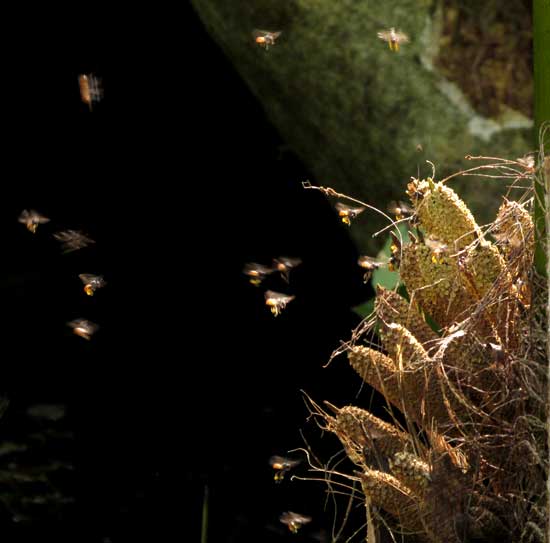
Those are bees apparently gathering pollen from bursting anthers. Interestingly, the male flowers in our earlier section were photographed in February, so with these September-maturing ones it's apparent that flowering isn't just once a year at a specific season. I could find no female trees to dust with pollen from this tree.